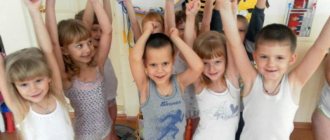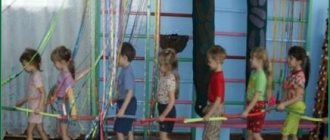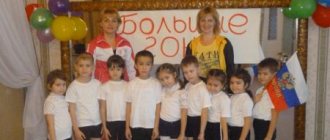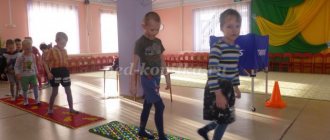Complexes of general developmental exercises for older children
Ekaterina Alekyan
Complexes of general developmental exercises for older children
Complexes of general developmental exercises for older children
Morning exercises
June 1 week
1. "On the toe"
I. p.: feet shoulder-width apart, arms down. 1-head tilt to the right (left, right (left)
foot to the side on the toe, raise your right
(left)
hand to the side; 2nd. p.Pov: 6-8 times.
2. Side bends
I. p.: the same, hands to shoulders. 1-tilt to the right (left, 2nd p., 3-tilt to the right (left)
with hand, 4th. p. Rep. 4-6 times.
3. Bends down
I. p.: the same. 1- bend forward, arms to the sides, 2-i. n., 3-tilt down, reach the floor, 4-i. p.Pov: 4-6 times.
4. "We play with our toes"
I. p.: sitting on the floor, legs together, hands resting behind. Alternately raise and lower your toes.
5. "Scissors"
I. p.: lying on your elbows. Straight leg cross movements.
6. "Boat"
I. p.: lying on your stomach, arms straight. 1-raise your straight arms and legs up, bend your back, 2-i. p.Pov: 6-8 times.
7. Turns
I. p.: standing, feet shoulder-width apart, hands to shoulders. 1-turn right (left, right (left)
move your hand back, look at your palm, 2nd. p.Pov: 6-8 times.
8. Jumping
I. p.: one leg in front, the other behind, hands on the belt. Swap your legs while jumping. Alternate with breathing exercises or walking .
June 2 week
1. "Scissors in Motion"
I. p.: standing, feet shoulder-width apart, arms straight in front of you. Cross movements of the hands in front of you up and down.
2. Side bends
I. p.: the same, hands behind the head. 1-tilt to the right (left, 2nd p.Pov: 6-8 times.
3. Lunges
I. p.: o. s., hands on the belt. Place your straight leg back on your toes as far as possible, bend the other leg. Do a few springy squats. Change legs.
4. "The sock is jumping"
I. p.: sitting on the floor, hands resting behind. Bend one leg, with a sharp toe touching the floor on one side of the other leg, on the other. Same with the other leg.
6. "Sit down"
I. p.: lying on your back, boys hands behind their heads, girls straight. 1-sit, 2i. p.Pov: 6-7 times.
7. "Ring"
I. p.: lying on your stomach, arms resting in front of your chest. Straighten your arms, lower your head back, try to touch your toes to your head.
8. Jumping
I. p.: legs together. When jumping, move your legs to one side and the other. Alternate with breathing exercises or walking .
June 3 week
1. "Behind your back"
I. p.: standing, feet shoulder-width apart, hoop grip from the sides below. 1- raise the hoop up, 2- lower it by the shoulders, 3,4- and. p.Pov: 6-7 times.
2. Side bends
I. p.: standing, feet shoulder-width apart, hoop below. 1- lift the hoop horizontally up, 2- tilt to the right (left, 3.4- etc. P.R.: 6-8 times.
3. Bends down
I. p.: standing, feet shoulder-width apart, hoop on the floor behind the feet, hands on the belt. 1- tilt down, reach the hoop, 2- and. p.Pov: 6-7 times.
4. Squats
I. p.: standing, heels together, toes apart, hoop below. 1- sit down, keep your back straight, spread your knees, bring the hoop forward. 2-i. p.Pov: 6-7 times.
5. "Don't touch me"
I. p.: sitting, legs bent, hoop in front of feet. 1- legs apart, put on the floor, 2- and. p.Pov: 5-6 times.
6. "Bridge"
I. p.: sitting, hands resting behind, legs in a hoop bent at the knees. 1- raise your torso up, make a bridge, 2- and. p.Pov: 6-7 times.
7. Turns
I. p.: standing, feet shoulder-width apart, hoop pressed to the chest. 1- bring the hoop forward, 2- turn to the right (left, 3.4-i.p.Pov: 6-8 times.
8. Jumping on two legs through a hoop back and forth with your back. Alternate with walking with an extended step along the hoop of the hand on the belt
June 4 week
1. "On the toe"
I. p.: o. With. hands with the ball behind the head. 1- raise your hands up, look at the ball, right (left)
foot back on the toe, 2-and. p.Pov: 5-7 times.
2. Side bends
I. p.: standing, feet shoulder-width apart, ball below. 1- lift the ball up, 2- lean to the right (left, 3-4 etc. Pov: 6 times.
3. Bends down
I. p.: standing, feet wider than shoulder width, ball pressed to the chest. 1-lean down, show the ball to the neighbor behind you, 2-i. P.
Pov: 5-7 times.
4. Squats
I. p.: o. With. the ball is pressed to the chest. 1- sit down, bring the ball forward, 2- and. p.Pov: 6-7 times.
5."Lift up"
I. p.: sitting, hands resting behind, the ball sandwiched between the soles of the feet. 1- raise the ball up, 2- and. p.Pov: 5-7 times.
6. "Get Up"
I. p.: lying on your back, the ball is sandwiched between the soles of your feet, your arms are straight behind your head. 1- swing your arms, sit down without releasing the ball, without lifting your feet from the floor, 2- i. p.Pov: 6 times.
7. Leg swings
I. p.: o. With. ball in hands above head. 1- lower the ball onto the raised right (left)
knee, 2-i. p.Pov: 6-8 times.
8. Turns.
I. p.: standing on your knees, the ball pressed to your chest. 1- turn to the right (left, put the ball between your legs, 2- i.p., 3- turn to the right (left, take the ball, 4- i.p.Pov: 6 times.
9. Jumping with a ball sandwiched between your knees. Alternate with walking.
Complexes of general developmental exercises for children
preparatory group
Morning exercises
July 1 week
1. Normal walking, gymnastic step, walking in a half squat, walking in a full squat, running at an average pace.
2. Slow walking with arms raised up to restore breathing
Forming into columns in units without music
Exercises without objects
1. I. p. - basic stance, hands on the belt. 1 - hands behind the head, right (left)
foot back on toe;
2 - return to the starting position (8 times)
.
2. I. p. - stand with your feet shoulder-width apart, hands on your belt. 1 - arms to the sides; 2 - tilt down to the right (left)
leg, clap your hands behind the leg;
3 - straighten up, arms to the sides; 4 - starting position (4 times)
.
3. I. p. - stand with your feet shoulder-width apart, hands behind your head. 1 — turn to the right (left, right hand to the side; 2 — starting position (4 times in each direction)
.
4. I. p. - kneeling position, arms along the body. 1-2 - sit on the right (left)
on the hip, arms forward;
return to the starting position (4 times)
.
5. I. p. – kneeling position, hands pointing in front. 1 – extend the right leg up, 2 – I. p., 3 – extend the left leg up, 4 – i. P.
6. I. p. - sitting on the floor, hands supported behind. 1 - raise straight legs forward and upward - angle; 2 - return to starting position (5-6 times)
.
7. I. p. - basic stance, hands on the belt. Jumping on two legs - left forward, right backward, jump to change the position of the legs. Performed counting 1-8, walking and jumping again (2 times)
.
8. Breathing exercise . They raised their hands up and lowered them.
July 2 week
1. Walking.
2. walking with high knees ( “horses”
)
3. walking in a full squat ( “goose step”
)
4. running with jumping (children run during the first part of the music, and do 3 jumps during the second part)
Rebuild in 2 (3)
columns in links without music.
Exercises with a large diameter ball
1. I. p. - basic stance, ball in both hands below. 1 - lift the ball up; 2 — step right (left)
;
3 - put your foot down; 4 - return to the starting position (8 times)
.
2. I. p. - stand with your feet as wide as your feet, holding the ball in bent arms in front of you. 1-2 - sit down, ball forward; 3-4 - return to starting position (8 times)
.
3. I. p. - stand with legs apart, ball in both hands below. 1 - ball up, arms straight; 2 — turn right (left)
;
3 - straighten up, ball up; 4 - return to the starting position (4 times in each direction)
.
4. I. p - sitting, legs together, ball on feet, hands supported behind. 1-2 - raise your legs up, roll the ball onto your stomach, catch it; 3-4 - return to starting position (5-6 times)
.
5. I. p. - main stance, ball below. 1-2 - rising on your toes, lift the ball up; 3-4 - return to starting position (8 times)
.
6. Throwing the ball up and catching it, alternating with jumping
7. Jumping with a ball between your legs.
8. I. p. – basic stance, ball in both hands below. 1 – lift the ball up; 2 – lower down, 3-4 repeat 1-2.
July 3rd week
1. Walking in a column one at a time, changing the position of the hands at the teacher’s signal
2. Game exercise “Penguins”
(walking on toes, raising your arms up, walking in a half-squat, walking in a full squat)
3. running
4. breathing exercises
Walking in a column one at a time with formation of 3 columns in links (to music, walking in place
Exercises without objects
1.. I. p. - basic stance, hands on the belt. 1 - lunge to the right, hands behind the head; 2 - starting position. Same to the left (6 times)
.
2. I. p. - stand with legs apart, hands on the belt. 1 — tilt to the right (left)
;
2 - starting position (4 times in each direction)
.
3. I. p. - basic stance, hands on the belt. 1-2 - sit down, arms forward; 3-4 - return to starting position (8 times)
.
4. I. p. - kneeling position, hands on the belt. 1-2 - turn the body to the right (to the left, touch the heel of the left leg with your right hand; 3-4 - return to the starting position (4 times in each direction)
.
5. I. p. - basic stance, hands on the belt. On the count of 1 beat - jump on the right leg; on the second beat of music - walking, the same on the left leg. Repeat the jumps twice with a short break.
Formation in one column (to music, walking
July 4 week
1. Walking in a column one at a time
2. Walking with side steps (in both directions)
3. Gymnastic walking (toe walking)
4. Running
5. Running with the shin thrown back ( “slap your heels on the butt”
)
6. Calm walking with arm swings to restore breathing
Walking in a column with formation of 3 columns in links (to music, walking in place
Exercises with bands
1. I, p. - main stand, tapes at the bottom. 1 — tapes forward; 2 — tapes up; 3 — tapes to the sides; 4 — starting position (8 times)
2. I. p. - stand with feet shoulder-width apart, ribbons at the chest. 1 — turn to the right (left, right hand to the side; 2 — starting position (4 times in each direction)
.
3. I. p. - main stand, ribbons below. 1-2 - sit down, bring the ribbons forward; 3-4 - starting position (6 times)
.
4. I. p. - stand with feet slightly wider than shoulders, bands at the bottom. 1 — tapes to the sides; 2 — forward tilt; 3 - straighten up, arms to the sides; 4 — starting position (6 times)
.
5. I. p. - main stand, ribbons below. Jumping on two legs with free swings of arms
6. I. p. - main stand, ribbons below. 1-2 - put the right leg back on the toe, ribbons up; 3-4 - return to the starting position. Same with the left foot (8 times)
.
Formation in one column to music
August 1 week
1. Walking in a column one at a time.
2. walking, waddling from foot to foot (like bears, walking on toes (mice)
3. Walking with the knees raised high, arms bent at the elbows, forearms parallel to the floor, children hitting their knees with their palms (horses)
4. Running
Walking in a column one at a time (while walking, children take hoops, rebuilding into two (three)
columns in links
Hoop exercises
5. I. p. - main stance, hoop at the bottom. 1 - lift the hoop forward; 2 - lift the hoop up; 3 — hoop forward; 4 - return to starting position (8 times)
.
6. I. p. - stand with your feet shoulder-width apart, hoop on your chest, grab your hands from the sides. 1 - turn the body to the right (left, hoop to the right, arms straight; 2 - return to the starting position (6 times)
.
7. I. p. - basic stance, grip of hands from the sides, hoop on the chest. 1 - sit down, bring the hoop forward; 2 - return to starting position (6 times)
.
8. I. p. - stand with feet shoulder-width apart, hoop at the bottom. 1 - lift the hoop forward; 2 — lean forward, look “out the window”
;
3 - straighten up, hoop in front; 4 - starting position (8 times)
.
9. I. p. - basic stance near the hoop, hands freely. Jumping on two legs around a hoop in both directions, alternating with walking. Repeat 2 times.
August 2 week
1. Walking
2. walking in a column, one at a time, on heels and toes
3. Running with acceleration
4. calm walking to restore breathing
Walking in a column one by one, forming three columns in links
Exercises without objects
5.. I. p. - basic stance, arms along the body. 1 - arms to the sides; 2 - bending your arms towards your shoulders, rise onto your toes; 3 - lower your entire foot, arms to the sides; 4 - return to starting position (6 times)
.
6. I. p. - stand with your feet shoulder-width apart, hands on your belt. 1 - turn the body to the right (to the left, right arm to the side; 2 - return to the starting position (4 times in each direction)
.
7. I. p. - stand with your feet at the width of your feet, arms at the top. 1-2 - squat deeply, hands behind your head, bringing your elbows forward; 3-4 - return to starting position (6 times)
.
8. I. p. - stand with your feet shoulder-width apart, hands on your belt. 1 - arms to the sides; 2 — tilt to the right (left, right hand down, left hand up; 3 — straighten up, arms to the sides; 4 — starting position (4 times in each direction)
9. I. p. - basic stance, hands down. 1 - jump legs apart, arms to the sides; 2 - jump with your feet together, arms down.
10. I. p. - basic stance, hands down. 1-2 - arms through the sides up; 3-4 - return to starting position (6 times)
.
Formation in one column, walking
Round dance game “Twist your arms, twirl your legs”
August 3rd week
1. Walking in a column one at a time, performing hand exercises
2. Walking in a full squat
3. Walking with side steps
4. Running
5. Restoring breathing
Walking (while walking, children take blocks, form three columns in links, walk in place
Exercises with a cube
1. I. p. - leg stand at the width of the foot, cube in the right hand. 1-2 - raise your arms up through your sides, transfer the cube to your left hand; 3-4 - starting position (8 times)
.
2. I. p. - stand with legs apart, cube in right hand. 1 - arms to the sides; 2 - bend forward, place the cube at the toe of the left foot; 3 - straighten up, arms to the sides; 4 - bend down and take the cube in your left hand. The same with the left hand (8 times)
.
3. I. p. - leg stand at the width of the foot, cube in the right hand. 1 - arms to the sides 2 - sit down, cube forward, transfer to your left hand; 3 - stand up, arms to the sides, cube in your left hand, 4 return to the starting position. (4 times)
.
4. I. p. - kneeling, cube in right hand. 1 - turn to the right, place the cube at the toes; 2 - straighten up, hands on your waist; 3 - turn right, take the cube; 4 - return to the starting position, transfer the cube to your left hand. The same to the left (4 times each)
.
5. I. p. - basic stance, arms freely, cube on the floor. Jumping on the right and left leg around the cube, alternating with a short pause. Repeat 2 times.
Line up in one column, walk, while walking, children place cubes.
August 4 week
1. Walking in a column one at a time
2. Walking with side steps (in both directions)
3. Gymnastic walking (toe walking)
4. Running with acceleration
5. Slow walking with raising your arms up to restore breathing
Walking, forming three columns in links, walking in place
Exercises with dumbbells
1. I, p. - main stance, dumbbells below. 1 - dumbbells forward; 2 - dumbbells up; 3 - dumbbells to the sides; 4 — starting position (6 times)
.
2. I. p. - stand with feet shoulder-width apart, dumbbells at the chest. 1 - turn to the right (left, right hand to the side; 2 - starting position (8 times)
.
3. I. p. - main stance, dumbbells below. 1-2 - sit down, bring the dumbbells forward; 3-4 - starting position (8 times)
.
4. I. p. - stand with feet shoulder-width apart, dumbbells below. 1 - dumbbells to the sides; 2 — tilt forward to the left (right)
leg;
3 - straighten up, arms to the sides; 4 - starting position (4 times)
.
5. I. p. - main stance, dumbbells below. Jumping.
6. I. p. - main stance, dumbbells below. 1-2 - put your right leg back on your toes, dumbbells up; 3-4 - return to the starting position. The same with the left foot (6-8 times)
.
Formation in one column, walking in a column one at a time.
Airplanes
Constantly keeping your body in good physical shape is much easier than constantly tormenting yourself with weight loss diets. Morning exercises or exercises are just for this purpose.
By doing morning exercises every day, you charge your body with energy and vigor for the whole day.
Morning exercises include a simple set of physical exercises that need to be performed after waking up.
When performing a set of morning exercises with a moderate load, try to use all the muscles of the body. In addition, there are simple exercises for the buttocks and legs that can be performed at home.
By devoting just a few minutes every morning to a set of physical exercises, you will raise your vitality and improve your health.
SIMPLE MORNING GYMNASTICS COMPLEX
Morning exercises (exercises) will help: activate metabolism, improve cardiac activity, strengthen and shape muscles, and help maintain correct posture. Thus, after morning exercises, the entire body as a whole and each organ in particular awakens.
If you have insomnia, indigestion, or apathy, then morning exercises can help cope with these problems. Morning exercises are useful for everyone, both preschool children and the elderly; it is especially recommended for office employees who lead a sedentary lifestyle.
MORNING GYMNASTICS - A COMPLEX OF SIMPLE EXERCISES
Morning exercises help women and men wake up faster and gain strength to confidently face a new day. You can start doing gymnastic exercises for girls without getting out of bed.
1. First, stretch, bending your whole body in different directions so that all the muscles tense. Inhale the air deeply and hold it, then exhale. Repeat this 5 times.
2. Now do hand squeezes. Do them vigorously 5 times. This exercise normalizes blood circulation.
3. Lying on your back, bend your knees. Hold them close to your chest and wrap your arms around them. Alternately bend and straighten your legs, bringing them to a straightened position, while creating counteraction with your hands. It will be more effective to breathe correctly. Perform 3 approaches.
4. Lower your legs from the bed while sitting, slowly rotate your head in a circle 5 times to the left, then change direction. Perform rotations with your eyes closed.
A universal set of exercises for morning exercises
Once you have developed the core muscles, you can begin more intense movements:
- Place your feet shoulder-width apart, raise your arms and lower them smoothly, accompanying this movement with a long exhalation. As you raise your arms, inhale as much as possible. Repeat 5 times;
- bend your elbows and grab your shoulders. Make vigorous circular movements forward, then backward 10 times;
- Bend your elbows and hold them in front of your chest, placing your palms on top of each other. Spread them 2 times to the sides, immediately in a bent state, then in an unbent state;
- Place your hands on your waist and smoothly rotate your body in a circle. Then bend your body back and forth, left and right. Do each exercise 7–10 times.
- standing with your feet shoulder-width apart, raise one arm up and rest the other on your side. Bend alternately left and right as much as possible, without bending your body forward. If your right arm is raised, then bend to the left, and vice versa;
- do squats with your arms raised. When squatting, swing your arms down, and when rising, raise your arms to the starting position. For optimal results, squat 10 times;
- Place your feet shoulder-width apart, stretch your arms in front of you, parallel to the floor, touch the toe of your right foot to your left palm and place it in the starting stance. Then touch the toe of your left foot to your right palm. Do these swings 5 times with each leg;
- Press your feet together and place your hands at a moderate height, palms down. We jog in place, try to touch your knees to your palms alternately.
It is advisable to perform this set of morning exercises for women and men in the given order, from top to bottom, so that the muscles are developed one by one.
If you have free time in the morning, you can supplement the set of morning exercises with strength techniques: pumping up your abs, doing push-ups. You can diversify your exercises by using a hula hoop (hoop), an expander, or dumbbells of various weights.
MORNING EXERCISES - GENERAL RECOMMENDATIONS
Doctors' recommendations for choosing a specific set of physical exercises for morning exercises for men, women, children and the elderly usually depend on age and gender.
For men, they advise including strength exercises, actively using dumbbells, expanders, rubber bandages, but not getting carried away with static tension.
Women are advised to focus on developing flexibility, strengthening the abdominal and pelvic floor muscles.
For older people, it is better to avoid strength exercises, as well as fast pace. It is better to give preference to breathing exercises and self-massage of the neck and head.
For children, doctors recommend general strengthening physical exercises that develop correct posture, as well as flexibility and coordination, and strengthen the muscles of the abdomen, neck, back, and arch of the foot.
Morning exercises for women and men should bring pleasure and a surge of vital energy. If you feel tired after doing morning exercises, you feel depressed and begin to feel short of breath, then it is better to simplify your morning exercise routine or take a break for a few days. Perhaps there is a reason to go to a training session at a sports and recreation center.
STRETCHING AFTER MORNING GYMNASTICS
A set of morning exercises should end with stretching. You can learn about what stretching is from the previous publication “Stretching is a set of exercises for the whole body.”
It is worth noting that these morning exercises will not help you do the splits or quickly build muscle. But, doing them regularly will help the body invigorate and recharge itself for the rest of the day for fitness.
The entire stretching program will take you no more than 5 minutes:
- Relaxation of the posterior surface of the pelvis. Lie on your back and clasp your relaxed leg with both hands. Forcefully pull it towards your chest as much as possible. As soon as you feel a pleasant burning sensation in the pelvic area, immediately stop the force on your lower limb and lock in this position for 30 seconds. The same movement is repeated with the other leg;
- Relieving neck fatigue after sleep. Without changing your position, bend your knees and clasp the back of your head with both hands. Begin to pull your head towards your chest, remembering to completely relax your neck. When you feel a slight burning sensation in the neck area, stop moving towards your chest and hold for 5 seconds. Repeat at least 5 times;
- Body stretching. This exercise is perfect for a comprehensive morning stretch. Try to relax as much as possible while lying on your back. Place your hands behind your head and begin to pull your limbs in opposite directions. You need to stretch for 20-30 seconds;
- Groin stretch. To make the exercise easier, you can take a pillow and place it behind your head. When lying down, you need to sit cross-legged. Try to relax your body and thoughts as much as possible. With the right attitude, your knees should move in different directions under their own weight. Completed within 1 minute;
- Forward bends are the final stretching exercise. Straighten up and bend down as low as possible, touching your fingers or palms to the floor. Fix yourself in this state for a few seconds. Every day, try to increase the duration of fixation in a bent position.
You can find out how to play sports during self-isolation here.
We recommend reading: What you need to know about powerlifting






